| کد مقاله | کد نشریه | سال انتشار | مقاله انگلیسی | نسخه تمام متن |
|---|---|---|---|---|
| 4465997 | 1622164 | 2015 | 15 صفحه PDF | دانلود رایگان |

• Gyrophyllites kwassizensis is a burrow of a worm following migrating redox boundary.
• It is filled with mud from underlying layer, more nutritional than surface sediments.
• Tracemaker incidentally invaded slope-apron sediments, partly irrespective of facies.
Gyrophyllites kwassizensis Glocker occurs abundantly in deep-sea, density current siliciclastics of the Istebna Formation (Silesian Nappe, Outer Western Carpathians; Poland, Slovakia and Czech Republic), close to the Cretaceous–Palaeogene boundary. It is composed of petal-shaped lobes radiating from a thin shaft, forming rosettes on a few levels in the sediment. The trace fossil is interpreted as a feeding structure produced by a soft-body “worm”, which actively filled the lobes with mud transported from the underlying layer, probably in response to migration of redox boundary in a generally poorly oxygenated environment. Probably due to microbial decomposition of cellulose and other organic particles, the mud from below was more nutritional than the more fresh mud from the sea floor. The number of lobes in a rosette (from 7 to 15) is referred to ontogenetic development of the tracemaker and indirectly to time of burrow occupation. The number varies between localities and may indicate a more hospitable habitat in the areas where the number is higher. G. kwassizensis occurs only in a narrow stratigraphic interval after a significant drop of sedimentation rate caused by non-eustatic reasons, in facies conditions, which are not unique during the long history (Late Jurassic–Miocene) of the external Carpathian subbasins. This suggests that facies control was less important for distribution of this trace fossil than some undetermined biological factors, which enabled successful, but incidental invasion of the tracemaker to deep-sea floor of one of the subbasins – the Silesian Basin.
Journal: Palaeogeography, Palaeoclimatology, Palaeoecology - Volume 426, 15 May 2015, Pages 260–274